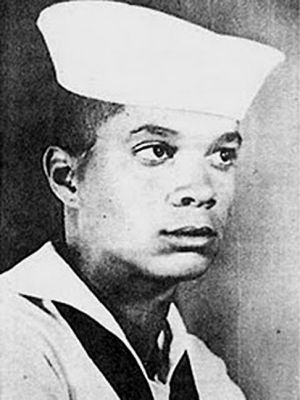Sammy Younge Jr. facts for kids
Quick facts for kids
Sammy Younge Jr.
|
|
|---|---|

Official image of Sammy Younge Jr. as an enlisted member in the United States Navy.
|
|
| Born |
Samuel Leamon Younge Jr.
November 17, 1944 Tuskegee, Alabama, U.S.
|
| Died | January 3, 1966 (aged 21) Tuskegee, Alabama, U.S.
|
| Cause of death | Murder |
| Known for | Civil rights activist; first black college student activist murdered during the Civil Rights Movement |
Samuel Leamon Younge Jr. (November 17, 1944 – January 3, 1966) was an important activist. He worked for civil rights and voting rights for African Americans. He was killed because he tried to use a "whites only" restroom.
Younge had served in the United States Navy for two years. He was an active member of the Student Nonviolent Coordinating Committee (SNCC). He also led the Tuskegee Institute Advancement League.
Samuel Younge Jr. was the first African-American university student to be killed in the United States. This happened because of his actions supporting the Civil Rights Movement. Three days after his death, SNCC became the first civil rights group to speak out against the Vietnam War. They felt that innocent people, like Younge, should not face deadly violence.
Contents
Early Life and Education
Samuel Younge Jr. was born on November 17, 1944. His hometown was Tuskegee, Alabama. His father, Samuel Younge Sr., was an occupational therapist. His mother was a local schoolteacher.
From 1956 to 1958, Younge attended Cornwall Academy in Massachusetts. He graduated from Tuskegee Institute High School in 1962. After high school, he joined the United States Navy.
Younge served in the Navy from 1962 until July 1964. He received a medical discharge because he had a kidney removed. In 1965, he began studying political science at the Tuskegee Institute.
Working for Civil Rights
Younge became involved in the Civil Rights Movement during his first semester at Tuskegee Institute. He joined the Selma to Montgomery protest march in March 1965. This march was against the "Bloody Sunday" incident.
He joined SNCC and the Tuskegee Institute for Advancement League (TIAL). TIAL was a local student group formed with SNCC's help. Younge soon began leading protests against unfair civil rights practices in Alabama.
In April 1965, he went to Mississippi. There, he worked with Unita Blackwell and Fannie Lou Hamer. They helped the Mississippi Freedom Democratic Party register Black voters. In the summer of 1965, Younge led Tuskegee Institute students. They challenged clear discrimination in Tuskegee.
The group tried to enter white-only restaurants. They held rallies and protested businesses that would not hire Black people. Several times, they tried to attend segregated white churches. They were badly beaten twice for doing so. In September 1965, Younge was arrested and jailed. This happened after he tried to drive a group of African Americans to register to vote in Lee County, Alabama.
Younge continued his efforts to register Black people to vote. He worked in Macon County, Alabama. He kept doing this for four months after being released from jail, until his death.
His Death
On January 3, 1966, Samuel Younge Jr. was shot. He was at a Standard Oil gas station in Tuskegee, Alabama. Marvin Segrest, a 68-year-old white gas station attendant, shot him.
The shooting happened after Younge and Segrest had an argument. Younge had tried to use the "whites-only" bathroom.
Younge became the first Black college student to be killed. This happened because of his actions supporting the Civil Rights Movement. Samuel Younge Sr. spoke about his son's death. He said, "This is an era of social revolution. In such revolutions, individuals sacrifice their lives."
The Trial and Its Aftermath
Marvin Segrest was arrested on January 4, 1966. He was released on a $20,000 bond. He was charged with murder. His trial began on December 7.
The trial was moved from Macon County to Lee County. In Macon County, Black people outnumbered white people. An all-white jury found Segrest not guilty the next day. This decision caused angry protests in Tuskegee.
Honoring His Memory
In January 1966, a protest against Younge's death took place. It was held in front of the White House. Leslie Bayless led the protest. He brought a coffin with a picture of Younge on it. Police removed the coffin and arrested Bayless.
SNCC's Response
After Younge's death, SNCC decided to publicly oppose the United States' involvement in the Vietnam War. On January 6, 1966, they released a statement. It said:
The Student Nonviolent Coordinating Committee has a right and a responsibility to disagree with United States foreign policy when it chooses. The Student Nonviolent Coordinating Committee now states its opposition to United States' involvement in Vietnam for these reasons: We believe the United States government has been dishonest in its claims of caring for the freedom of the Vietnamese people. This is just as the government has been dishonest in claiming to care for the freedom of people of color in other countries. These include the Dominican Republic, the Congo, South Africa, Rhodesia, and in the United States itself. ... The killing of Samuel [Younge] in Tuskegee, Alabama, is no different from the killing of ordinary people in Vietnam. Both [Younge] and the Vietnamese people sought, and are seeking, to gain the rights guaranteed to them by law. In each case, the United States government is largely responsible for these deaths. Samuel [Younge] was killed because United States law is not being enforced. Vietnamese people are killed because the United States is following an aggressive policy that breaks international law. — Press release: The Student Nonviolent Coordinating Committee

